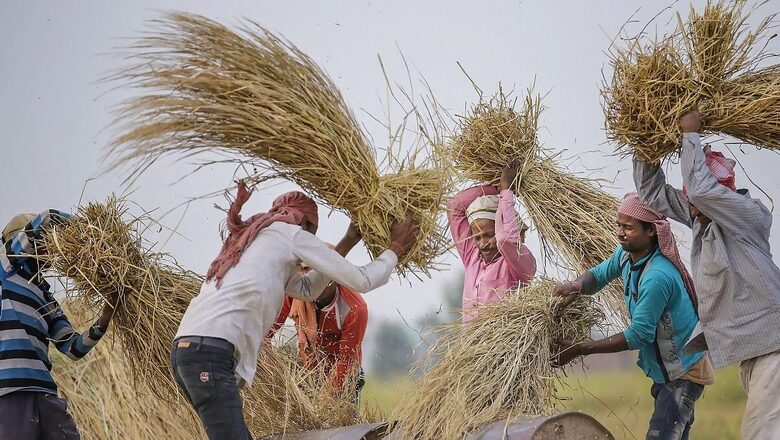
views
The Union Budget 2024 has ushered in a comprehensive strategy aimed at addressing the multifaceted challenges faced by the Indian agriculture sector while opening up a myriad of opportunities for growth and sustainability. The government’s budgetary allocations and policy announcements reflect a keen understanding of the sector’s needs, particularly in enhancing productivity, developing climate-resilient varieties, and promoting sustainable practices.
Agricultural Research: A Strategic Overhaul
A significant highlight of the budget is the emphasis on agricultural research. The government’s decision to comprehensively review the agricultural research setup signals a proactive approach towards increasing productivity and developing climate-resilient crop varieties. Funding for research will be provided in a challenge mode, encouraging innovation from both the public and private sectors. This move is poised to foster a competitive environment, driving advancements in agricultural science. The inclusion of domain experts from various fields to oversee research ensures that the efforts will be both holistic and impactful.
Release of New Varieties: Enhancing Crop Resilience
In a notable step towards agricultural resilience, 109 new high-yielding and climate-resilient varieties of 32 field and horticulture crops are set to be released. These new varieties promise to significantly boost productivity while also being better suited to withstand the adverse effects of climate change. This initiative aligns perfectly with the broader goals of food security and sustainability, providing farmers with the tools they need to adapt to changing environmental conditions.
Promoting Natural Farming: A Sustainable Path Forward
Natural farming has been given a substantial push, with plans to initiate 1 crore farmers into natural farming practices over the next two years. Supported by certification and branding, this initiative is expected to make a significant impact on sustainable agriculture. The establishment of 10,000 need-based bio-input resource centres will provide the necessary inputs and support to farmers. This initiative, implemented through scientific institutions and willing gram panchayats, aims to reduce dependency on chemical fertilisers and pesticides, thus promoting a healthier ecosystem.
Self-Sufficiency in Pulses and Oilseeds: A Step Towards Atmanirbharta
The budget has laid out a robust strategy to achieve self-sufficiency in pulses and oilseeds, critical components of the Indian diet. Strengthening their production, storage, and marketing will reduce import dependency and enhance farmers’ incomes. The focus on oilseeds such as mustard, groundnut, sesame, soybean, and sunflower is particularly noteworthy. By implementing a well-rounded approach encompassing the entire value chain, the government aims to achieve ‘atmanirbharta’ (self-reliance) in these essential commodities.
Vegetable Production and Supply Chains: Enhancing Market Efficiency
To cater to the growing demand for vegetables, the budget proposes developing large-scale clusters for vegetable production near major consumption centres. This strategy aims to shorten supply chains, reduce transportation costs, and ensure fresher produce reaches consumers. Promoting Farmer-Producer Organisations (FPOs), cooperatives, and startups in the vegetable supply chain will enhance collection, storage, and marketing efficiencies, thereby improving farmers’ profitability and consumer satisfaction.
Digital Public Infrastructure for Agriculture: Embracing the Future
The implementation of Digital Public Infrastructure (DPI) for agriculture represents a significant leap towards modernisation. Building on the success of the pilot project, the government, in partnership with states, will facilitate DPI implementation to cover farmers and their lands within three years. The digital crop survey for Kharif in 400 districts, along with the inclusion of 6 crore farmers and their lands in registries, underscores the commitment to data-driven agriculture. Additionally, the issuance of Jan Samarth-based Kisan Credit Cards in five states will streamline credit access, empowering farmers financially.
Boosting Shrimp Production and Export: Expanding Horizons
The budget also addresses the potential of shrimp farming, a crucial export-oriented sector. Financial support for establishing a network of Nucleus Breeding Centres for Shrimp Broodstocks will enhance the quality and productivity of shrimp farming. Facilitating financing through NABARD for shrimp farming, processing, and export will boost the sector, contributing to increased foreign exchange earnings and rural employment.
National Cooperation Policy: Strengthening the Cooperative Sector
The introduction of a National Cooperation Policy aims to foster systematic and orderly development of the cooperative sector. By fast-tracking the growth of the rural economy and generating large-scale employment opportunities, this policy seeks to harness the potential of cooperatives as engines of rural development. This comprehensive approach will ensure that cooperatives play a pivotal role in the agricultural value chain, from production to marketing.
Conclusion
The Union Budget 2024 has laid out a visionary roadmap for the Indian agriculture sector. By focusing on research, innovation, sustainability, and digital transformation, the budget addresses the core challenges while creating opportunities for growth. The emphasis on climate resilience, self-sufficiency, and cooperative development reflects a balanced and forward-looking approach. Effective implementation of these measures will be crucial in realising the full potential of the budget, ultimately leading to a more resilient, productive, and sustainable agricultural sector in India.
Jaiprakash Bisen is Scientist, ICAR; Arvind Kumar Mishra is Public Policy Expert. Views expressed in the above piece are personal and solely that of the author. They do not necessarily reflect News18’s views.



















Comments
0 comment